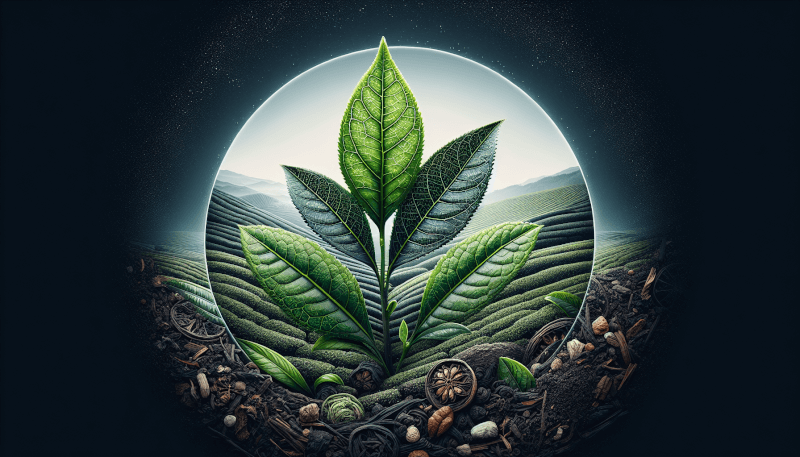Have you ever wondered how the taste of your favorite specialty tea is influenced by its terroir? Terroir, the unique combination of soil, climate, and geography, plays a crucial role in shaping the distinct flavors and characteristics of tea. In this article, we will explore the fascinating relationship between terroir and specialty tea flavor, and discover how the natural elements of a tea-growing region contribute to the delightful and diverse taste profiles that tea enthusiasts cherish. So, grab a cup of tea and join us on this flavorful journey through the world of terroir.

Defining Terroir in Specialty Tea
Terroir refers to the unique combination of environmental factors that influence the growth and development of tea plants, ultimately shaping the flavor characteristics of the harvested leaves. It encompasses a range of natural elements, including climate, soil composition, altitude, rainfall, sunlight exposure, microclimate, and the geographic region in which the tea is cultivated. These variables interact in intricate ways, giving rise to distinct tea flavor profiles that are specific to certain terroirs.
Terroir and Its Role in Agriculture
The concept of terroir has long been recognized in the world of agriculture and viticulture. It highlights the notion that the environment in which plants are grown profoundly impacts their flavor, aroma, and overall quality. In specialty tea production, the influence of terroir is equally significant. Just as grapes cultivated in different regions can produce wines with distinctive characteristics, tea grown in different terroirs offers a diverse range of tastes, aromas, and complexities that evoke a sense of place and identity unique to each origin.
Terroir and Its Influence on Specialty Tea
For tea enthusiasts and connoisseurs, the notion of terroir is a crucial aspect in understanding and appreciating the complexities of specialty teas. The diverse terroirs in which tea is cultivated contribute significantly to the wide array of flavors, aromas, and nuances found in specialty teas. By recognizing and appreciating the influence of terroir, tea enthusiasts can gain a deeper understanding and appreciation for the remarkable diversity and complexity found within the world of specialty tea.
Terroir Factors Affecting Specialty Tea Flavor
The flavor of specialty tea can be attributed to several key factors of terroir. Let’s delve into each of these factors and explore their impact on the taste and characteristics of tea.
Climate
Climate plays a fundamental role in tea cultivation and directly affects the flavors and aromas found in the harvested leaves. Factors such as temperature and humidity levels are critical in determining the physiological response of tea plants. Cooler climates may lead to teas with delicate and nuanced flavors, while warmer climates can produce bold and robust tea profiles.
Soil Composition
The soil in which tea plants grow significantly influences the taste and quality of the harvested leaves. The mineral content within the soil, organic matter, and nutrients directly affect the flavor and aroma of the tea. The pH level of the soil can also impact the extraction of certain compounds during brewing, ultimately altering the taste of the brewed tea.
Altitude
Altitude plays a crucial role in shaping the flavor and aroma profiles of specialty tea. As tea plants grow at higher altitudes, they encounter variations in temperature, air pressure, and oxygen levels. These environmental changes lead to slower growth and result in teas with more complex and subtle flavors, often characterized by floral, fruity, or herbaceous notes.
Rainfall and Irrigation
The amount of rainfall and the method of irrigation employed in tea cultivation can significantly impact the growth and flavor of tea plants. Adequate rainfall patterns ensure healthy plant growth and optimal leaf development, contributing to flavors that are well-rounded and balanced. Conversely, drought conditions or excessive irrigation can lead to compromised tea quality, affecting the taste and overall sensory experience.
Sunlight
Sunlight exposure directly influences the photosynthetic process within tea plants, which, in turn, affects the accumulation of chemical compounds responsible for flavor and aroma. The duration and intensity of sunlight can impact the balance between sweet, bitter, and astringent flavors in tea. The influence of sunlight exposure is particularly evident in shade-grown teas, which tend to exhibit a more delicate and nuanced flavor profile compared to teas grown in full sun.
Microclimate
Microclimate refers to the unique environmental conditions and localized climate patterns within a specific tea-growing area. Varying topography, airflow, and shelter from extreme weather conditions contribute to the creation of distinct microclimates. These microclimates can influence the flavor profiles of tea, with variations between teas grown in protected valleys, exposed hilltops, or near bodies of water.
Geography
The geographical region in which tea is cultivated plays a significant role in shaping the flavor and characteristics of specialty tea. Different countries, regions, and even individual tea gardens have their own distinctive microclimates and cultural practices, resulting in teas that possess a sense of identity and place. nuances.
Climate’s Impact on Tea Flavor
The temperature, humidity, and seasonal variations inherent in a tea-growing region significantly impact the flavor profile of specialty tea.
Temperature
Temperature affects tea plants’ metabolism and the rate at which flavor compounds develop within the leaves. Cooler temperatures can slow down this process, resulting in teas with delicate and nuanced flavors. In contrast, warmer temperatures can accelerate the accumulation of compounds, leading to teas with bolder and more pronounced flavors.

Humidity
Humidity levels in tea-growing regions influence the way tea plants grow and develop. In regions with higher humidity, plants may have larger, more succulent leaves. This can lead to teas with a sweeter and more full-bodied taste. In contrast, lower humidity levels can result in smaller leaves and teas that exhibit a crisper and more refreshing flavor profile.
Seasonal Variations
Tea plants undergo different growth stages throughout the seasons, and these changes are reflected in the resulting teas. Spring teas, often characterized by their freshness and delicate flavors, are highly sought after by tea enthusiasts. Summer teas, on the other hand, can exhibit more robust and mature flavors. The seasonal variations in temperature and rainfall also contribute to the unique taste profiles of teas harvested during different times of the year.
Soil Composition and Its Influence on Tea Taste
The soil composition in which tea plants grow directly influences the taste and quality of the harvested leaves.
Mineral Content
The minerals present in the soil are absorbed by tea plants, contributing to the development of specific flavors and aromas. For example, high levels of iron can impart a lively and brisk character to tea, while high potassium levels may result in teas with a smoother and silkier mouthfeel. Different soils rich in unique minerals contribute to the diverse flavor profiles found in specialty teas.
Organic Matter and Nutrients
The presence of organic matter in the soil is crucial for tea plant health and nutrient absorption. Healthy soils rich in organic matter provide tea plants with a balanced supply of essential nutrients, promoting optimal leaf development and contributing to flavors that are well-rounded and complex.
pH Level
The pH level of the soil affects the availability of various nutrients to the tea plants. Different pH levels can influence the extraction of compounds during brewing, ultimately altering the taste of the brewed tea. Acidic soils may yield teas that are brighter and more vibrant, while alkaline soils can produce teas with a smoother and rounder flavor profile.
The Role of Altitude in Specialty Tea
Altitude plays a significant role in shaping the flavor and aroma profiles of specialty tea.
Effect on Flavor and Aroma
As tea plants grow at higher altitudes, they are exposed to variations in temperature, air pressure, and oxygen levels. These environmental changes lead to slower growth and result in teas with more complex and subtle flavors, often characterized by floral, fruity, or herbaceous notes. The reduced oxygen levels at higher altitudes can also lead to the development of teas with enhanced aromas.
Temperature Variation at Different Altitudes
Temperature variations between day and night, as well as between different elevations, influence the chemical reactions occurring within tea plants. This temperature fluctuation contributes to the creation of teas with more layered and nuanced flavors. The wide range of temperatures experienced at different altitudes stimulates the production of different biochemical compounds, resulting in teas with unique taste profiles.
Growing Conditions and Leaf Quality
The environmental conditions at higher altitudes, including cooler temperatures, reduced sunlight exposure, and enhanced air circulation, promote slower growth and leaf development in tea plants. This slower growth results in leaves that are more delicate, tender, and packed with flavors. These leaves are highly sought after in the specialty tea market for their unique characteristics and exquisite taste.
Rainfall, Irrigation, and Water Source
The amount of rainfall, patterns of irrigation, and the water source used in tea cultivation significantly impact the growth and flavor of tea plants.
Impact on Tea Growth and Flavor
Adequate rainfall patterns are essential for the healthy growth and development of tea plants. Consistent water availability ensures optimal leaf expansion and nutrient uptake, resulting in teas with well-rounded and balanced flavors. Insufficient rainfall can lead to stressed plants, affecting the taste, appearance, and overall quality of the harvested tea leaves.
Rainfall Patterns
Different rainfall patterns in tea-growing regions can contribute to distinct flavor profiles. Areas with evenly distributed rainfall throughout the year can produce teas with consistent flavors. In contrast, regions with distinct wet and dry seasons may yield teas with dynamic and evolving taste profiles, reflecting the changing environmental conditions throughout the year.

Water Quality
The quality and mineral content of the water used for irrigation can influence the flavor of tea. High-quality water with balanced mineral composition contributes to tea plants’ healthy growth and facilitates the extraction of desirable compounds during brewing. The composition of the water can impact the overall taste, aroma, and mouthfeel of the brewed tea.
Sunlight Exposure and Specialty Tea
Sunlight exposure directly impacts the photosynthetic process within tea plants and, consequently, the flavor and quality of the harvested leaves.
Effect on Photosynthesis and Tea Flavor
Sunlight provides the energy necessary for tea plants to undergo photosynthesis, resulting in the accumulation of carbohydrates and flavor compounds within the leaves. The intensity and duration of sunlight exposure can influence the balance between sweet, bitter, and astringent flavors in tea. Controlled levels of sunlight exposure can lead to a more harmonious and balanced flavor profile.
Shade-Grown versus Sun-Grown Tea
Shade-grown teas, where tea plants are cultivated under partial or full shade, have gained significant popularity in recent years. The reduced sunlight exposure slows down the growth of tea plants, resulting in leaves with unique flavors and aromas. Shade-grown teas often exhibit a more delicate and nuanced taste profile, characterized by vegetal, floral, or umami notes. Sun-grown teas, on the other hand, tend to possess bolder and more robust flavors.
Tea Flavors Influenced by Sunlight
Sunlight exposure can influence the production of chemical compounds within tea leaves, contributing to the development of specific flavors and aromas. Different levels of sunlight exposure can impact the intensity of certain flavors in tea, such as the presence of floral notes in teas grown under ample sunshine or the development of vegetal flavors in shaded teas.
Microclimate’s Influence on Tea Taste
The unique environmental conditions within specific tea-growing areas, known as microclimates, contribute to the taste and characteristics of tea.
Unique Environmental Conditions
Microclimates are a result of various factors, including local topography, proximity to bodies of water, and the prevalence of wind patterns. These unique conditions create variations in temperature, humidity, and air circulation, influencing the growth and flavor development of tea plants. Teas grown in different microclimates can exhibit distinct taste profiles and aromas.
Local Topography and Airflow
The topography of a tea-growing region affects airflow patterns and the degree of exposure to wind. Sheltered valleys or hillsides may provide protection from strong winds, allowing tea plants to grow undisturbed. These variations in airflow and shelter can impact the flavors and aromas of tea, with teas grown in wind-protected areas offering a more delicate and nuanced taste experience.
Shelter and Protection from Extreme Weather
Microclimates can provide shelter and protection to tea plants from extreme weather conditions, such as heavy rains, storms, or excessive heat. The availability of natural protection can result in the development of teas with more balanced and consistent flavors, as the tea plants are shielded from environmental stressors that may otherwise compromise the quality and taste of the leaves.
Geographic Impact on Specialty Tea
The geographical region in which tea is cultivated holds inherent characteristics that shape the flavor and unique qualities of specialty tea.
Regional Tea Characteristics
Different tea-growing regions have distinctive climatic conditions, cultural practices, and tea plant varieties. These factors give rise to regional tea characteristics that are highly prized by tea enthusiasts. For example, teas from Darjeeling, India, are renowned for their floral and muscatel flavors, while teas from Yunnan, China, often possess earthy and malty notes.
Cultural Influences on Tea Cultivation
The cultural context in which tea is cultivated also plays a role in shaping the flavor and characteristics of specialty tea. The traditional farming methods, processing techniques, and the value placed on craftsmanship and tradition all contribute to the uniqueness of teas from different cultures. The cultivation and processing methods handed down through generations impart distinct flavors and aromas to teas from specific cultural areas.
Distinctive Flavors from Different Tea-Growing Regions
The diverse tea-growing regions around the world offer a vast array of flavor profiles, each distinct in its own right. From the delicately floral and aromatic high mountain oolongs of Taiwan to the bold and smoky Lapsang Souchong from Fujian, China, every region has its own signature taste experiences to offer. Exploring the distinctive flavors from different tea-growing regions allows tea enthusiasts to broaden their understanding of terroir and appreciate the variety that specialty tea has to offer.
Appreciating Terroir in Specialty Tea
To fully appreciate and enjoy specialty tea, it is essential to explore regional tea varieties, understand tasting notes influenced by terroir, and develop an understanding of tea’s origin.
Exploring Regional Tea Varieties
Sampling teas from different regions and terroirs is an excellent way to experience the breadth of flavors that specialty tea has to offer. Tasting teas side by side can highlight the nuances and characteristics unique to specific terroirs. By exploring regional tea varieties, tea enthusiasts can broaden their knowledge and deepen their appreciation for the impact of terroir on tea flavor.
Tasting Notes Influenced by Terroir
The tasting notes associated with specialty teas often reference the influence of terroir on the flavor, aroma, and overall sensory experience. Tasting notes may describe the various flavors, such as floral, fruity, vegetal, or earthy, that emerge due to specific terroir factors. By paying attention to tasting notes influenced by terroir, tea enthusiasts can develop a discerning palate and a better understanding of how different variables shape the flavor profiles of specialty teas.
Developing an Understanding of Tea’s Origin
Exploring the concept of terroir in specialty tea prompts tea enthusiasts to appreciate the origin and production methods behind their favorite teas fully. Developing an understanding of a tea’s origin allows for a more meaningful and immersive tea-drinking experience. By recognizing and honoring the influence of terroir, tea enthusiasts can connect with the rich history, culture, and heritage encapsulated in each cup of specialty tea.
In conclusion, terroir plays a vital role in defining the flavor and characteristics of specialty tea. Understanding the various terroir factors, such as climate, soil composition, altitude, rainfall, sunlight exposure, microclimate, and geography, allows tea enthusiasts to appreciate the unique tastes, aromas, and complexities that each tea-growing region offers. By exploring and acknowledging the influence of terroir in specialty tea, one can embark on a journey of discovery, developing a deeper understanding and appreciation for the remarkable diversity found within the world of tea. So next time you sip a cup of specialty tea, take a moment to reflect on the elements that have come together to create that unique and exquisite flavor.


